Are you planning your next Southeast Asian adventure? The best places to visit in Laos offer an authentic travel experience that’s increasingly rare in today’s over-touristed world. Often referred to as the “Land of a Million Elephants,” Laos presents travelers with a perfect blend of stunning natural landscapes, rich cultural heritage, and laid-back atmosphere that makes it ideal for backpackers seeking genuine experiences. In this comprehensive guide, we’ll explore the must-visit destinations in Laos for 2025, providing you with all the information you need to plan an unforgettable journey.
If you care too much about what other people think, you will always be their prisoner.
Laos Tzu
Why Laos Should Be Your Next Backpacking Destination
Before diving into specific locations, let’s understand what makes Laos such a compelling choice for adventurous travelers in 2025.

Authentic Cultural Experiences in Laos
Unlike some of its more commercialized neighbors, Laos offers a refreshingly authentic travel experience. The country’s relatively recent opening to tourism means many traditions and customs remain intact and genuine. From participating in the morning alms giving ceremony in Luang Prabang to exploring remote hill tribe villages on the Bolaven Plateau, Laos provides opportunities to witness and engage with living cultural practices rather than staged tourist attractions.
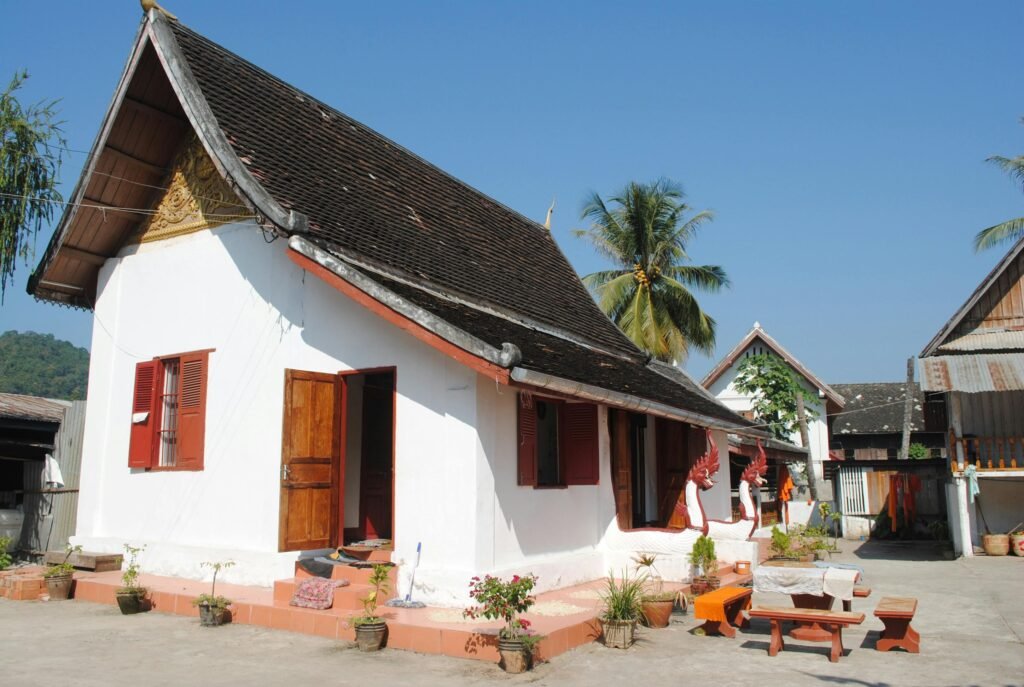
Natural Beauty Throughout Laos
Laos boasts remarkable ecological diversity despite being landlocked. From the limestone karst formations of Vang Vieng to the multi-tiered turquoise pools of Kuang Si Waterfall, the country’s landscapes offer breathtaking backdrops for adventure and photography. The lush jungles, winding rivers, and dramatic waterfalls create perfect settings for outdoor activities ranging from gentle hikes to adrenaline-pumping adventures.
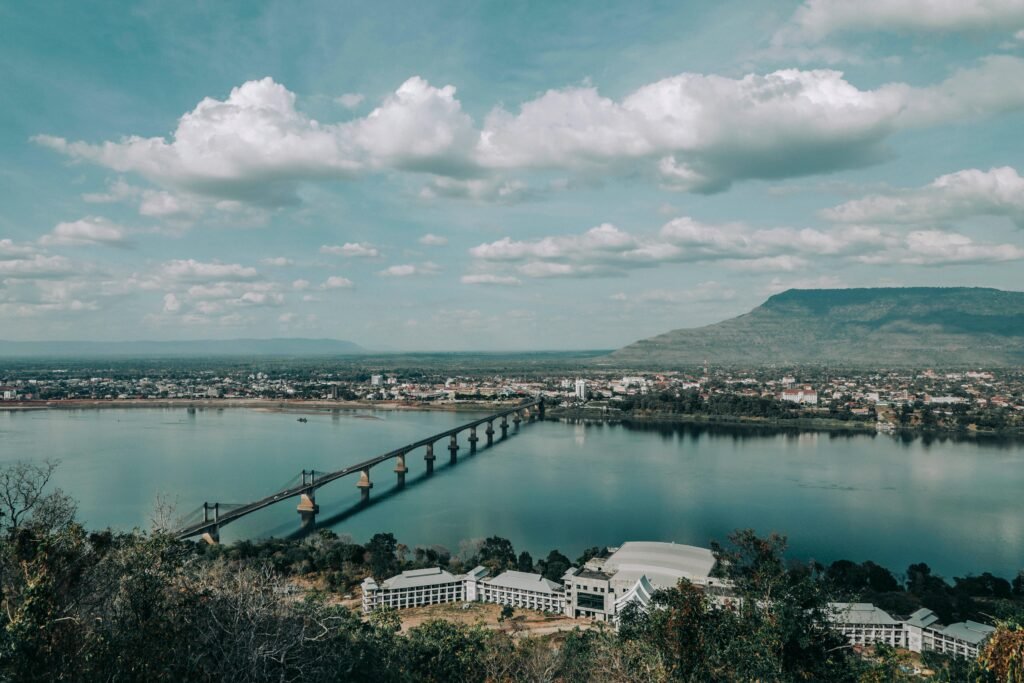
Image: Bridge in Pakse
Affordability for Budget Travelers
For backpackers watching their budget, Laos presents excellent value. Accommodations, food, and transportation remain reasonably priced compared to many other destinations in Southeast Asia. This affordability allows travelers to extend their stays, explore more thoroughly, and experience a wider range of activities without breaking the bank.
Off-the-Beaten-Path Appeal
While tourism in Laos has grown, it still receives significantly fewer visitors than neighboring Thailand or Vietnam. This means less crowded attractions, more authentic interactions with locals, and the genuine sense of discovery that many backpackers seek. Even in 2025, Laos retains its charm as a destination where you can find tranquility and authenticity.
Top Destinations Among the Best Places to Visit in Laos
Now, let’s explore the must-visit locations that should be on every backpacker’s Laos itinerary for 2025.
Luang Prabang: UNESCO Heritage and Spiritual Center
Luang Prabang, a UNESCO World Heritage city, stands as one of the absolute best places to visit in Laos. This ancient royal capital exudes a unique atmosphere where French colonial architecture blends seamlessly with traditional Lao temples and structures. The city’s location at the confluence of the Mekong and Nam Khan rivers adds to its picturesque quality.
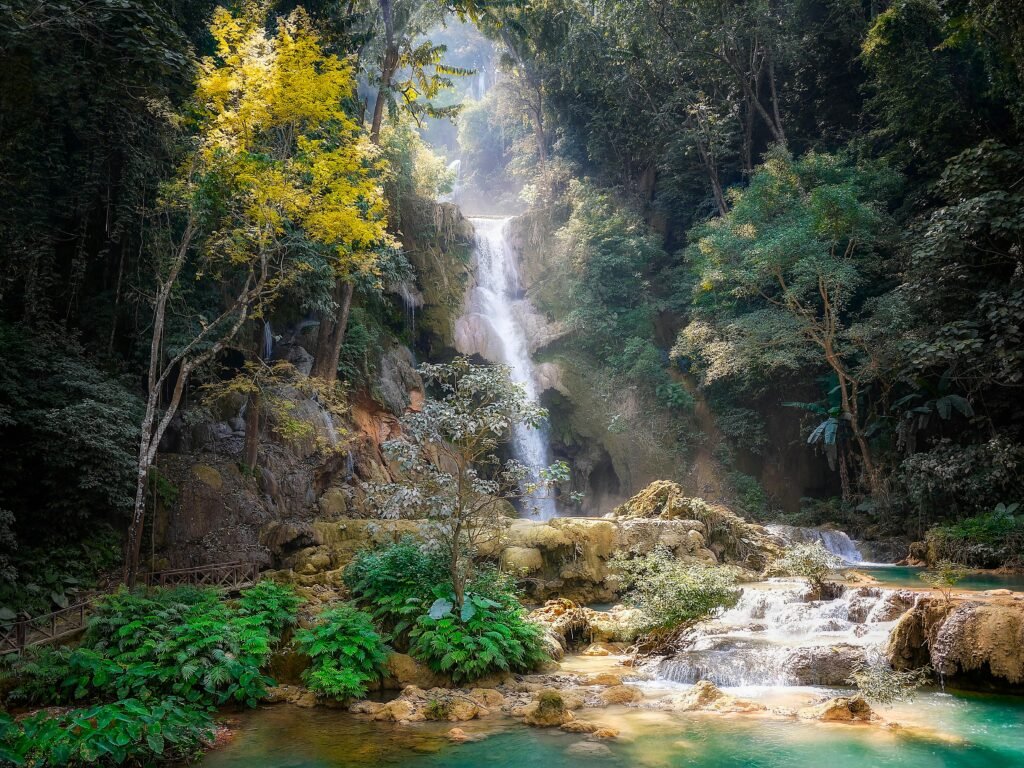
Image: Waterfall in Luang Prabang
Must-See Attractions in Luang Prabang:
- Wat Xieng Thong: Often considered the most magnificent temple in Luang Prabang, this 16th-century monastery showcases classic Luang Prabang architectural style with its sweeping roofs and intricate mosaics. The temple complex contains several buildings, including a funeral chapel with an impressive “tree of life” mosaic.
- Mount Phousi: Climbing the 328 steps to the summit of this 100-meter hill rewards you with panoramic views of Luang Prabang and the surrounding rivers and mountains. Sunset is particularly spectacular, though it can get crowded. Consider an early morning visit for a more peaceful experience.
- Morning Alms Giving Ceremony: Witnessing the daily ritual where monks collect offerings from locals is a profound cultural experience. If you choose to observe or participate, do so respectfully by maintaining distance and dressing modestly.
- Night Market: The evening market stretches along Sisavangvong Road, offering handicrafts, textiles, and street food. It’s the perfect place to pick up souvenirs and sample local delicacies in a vibrant atmosphere.
Practical Tips for Luang Prabang:
- The city center is compact and best explored on foot or by bicycle
- Consider staying in a traditional Lao wooden guesthouse for an authentic experience
- Dress modestly when visiting temples (shoulders and knees covered)
- The best time to visit is during the dry season (November to February)
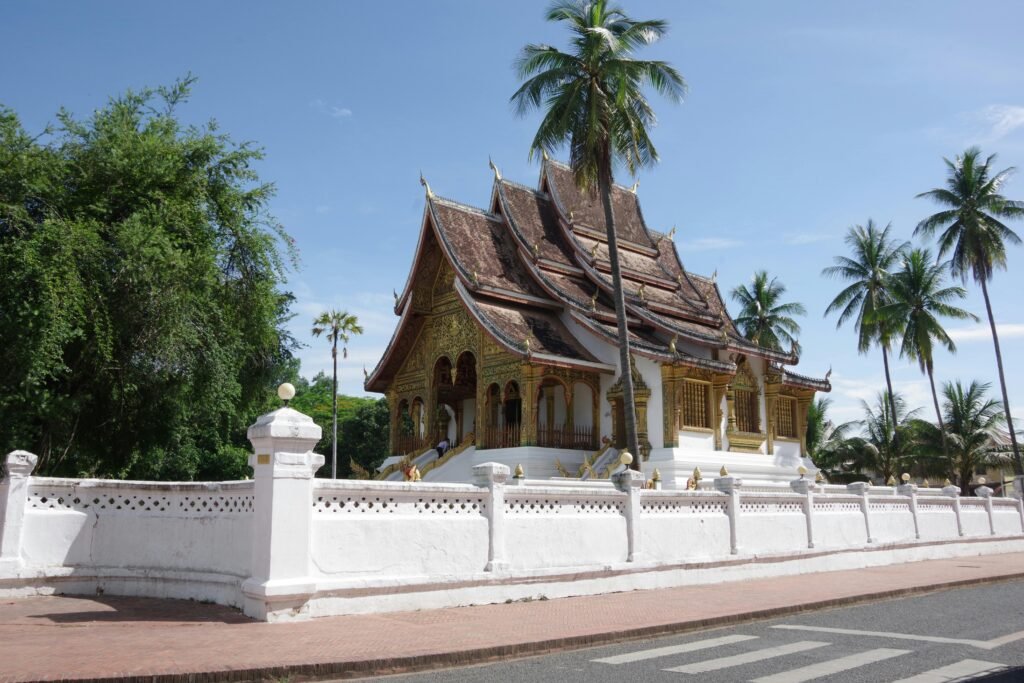
Image: Golden temples of Luang Prabang at sunset
Kuang Si Waterfall: Laos’ Natural Wonder
While technically located about 29 kilometers from Luang Prabang, Kuang Si Waterfall deserves its own spotlight as one of the best places to visit in Laos. This multi-tiered cascade creates a series of stunning turquoise pools that seem almost too perfect to be natural.
What Makes Kuang Si Special:
- Multi-Tiered Beauty: The waterfall consists of several tiers, each creating pools of varying sizes and depths. The main cascade drops about 60 meters, creating a spectacular visual.
- Swimming Opportunities: Many of the lower pools are perfect for swimming, offering a refreshing escape from the heat. The water maintains its striking blue-green color due to the high mineral content.
- Surrounding Nature: The falls are set within a lush jungle environment, with well-maintained paths allowing visitors to explore different levels of the cascade.
- Bear Rescue Center: Near the entrance, you’ll find the Free the Bears sanctuary, home to Asiatic black bears rescued from poachers and the illegal wildlife trade.
Visitor Information:
- Most easily accessed via tuk-tuk or shared minivan from Luang Prabang
- Visit early morning (before 9 AM) to avoid crowds and capture the best photos
- Bring swimwear, a towel, and water shoes for comfortable swimming
- The falls are most impressive during and just after the rainy season (May-October)
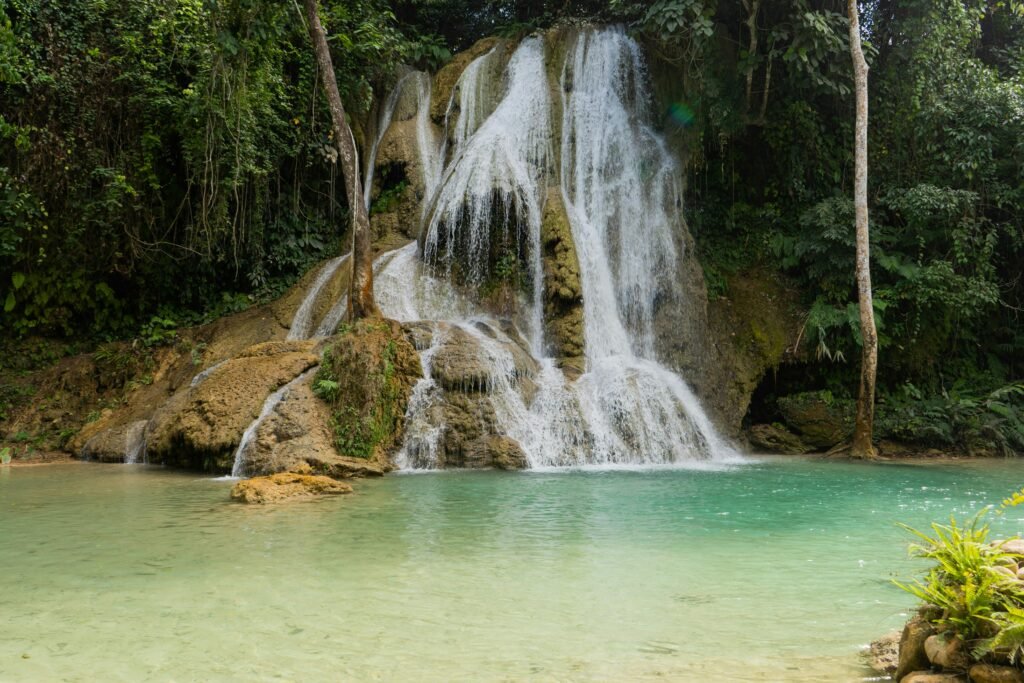
Image: Turquoise pools of Kuang Si Waterfall
Vientiane: Laos’ Charming Capital City
Unlike many chaotic Southeast Asian capitals, Vientiane offers a laid-back atmosphere that makes it one of the most pleasant best places to visit in Laos. The city blends French colonial influence with Buddhist architecture, creating a unique urban landscape that’s easy to navigate and enjoy.
Top Attractions in Vientiane:
- Pha That Luang: This golden stupa is the most sacred monument in Laos and appears on the national seal. The current structure dates to the 16th century, though the site has religious significance dating back much further. The golden exterior is particularly stunning at sunrise and sunset.
- Patuxai (Victory Monument): Often compared to Paris’ Arc de Triomphe, this war monument commemorates those who fought for independence from France. Climb to the top for panoramic views of the city.
- Wat Si Saket: The oldest surviving temple in Vientiane houses thousands of Buddha images in various sizes and styles. The cloister walls contain more than 2,000 ceramic and silver Buddha images.
- Buddha Park (Xieng Khuan): Located about 25km from the city center, this unusual sculpture park contains over 200 Hindu and Buddhist statues, including a massive reclining Buddha.
Practical Information:
- The city center is relatively compact and can be explored on foot
- Tuk-tuks provide convenient transportation for longer distances
- The Mekong riverfront comes alive in the evening with food stalls and markets
- Many restaurants offer excellent French-influenced Lao cuisine
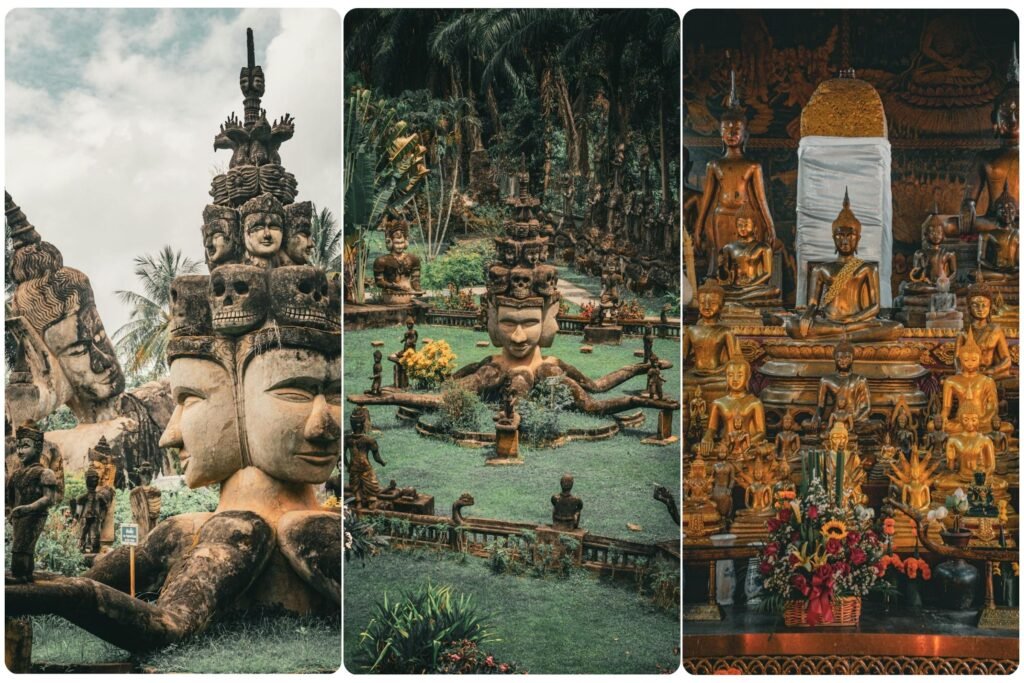
Image: Golden Pha That Luang stupa in Vientiane
Vang Vieng: Adventure Hub Among Limestone Karsts
Once notorious for wild parties, Vang Vieng has transformed into one of the best places to visit in Laos for outdoor adventures. The town is surrounded by dramatic limestone karst formations, creating a landscape that seems almost otherworldly and provides the perfect backdrop for various activities.
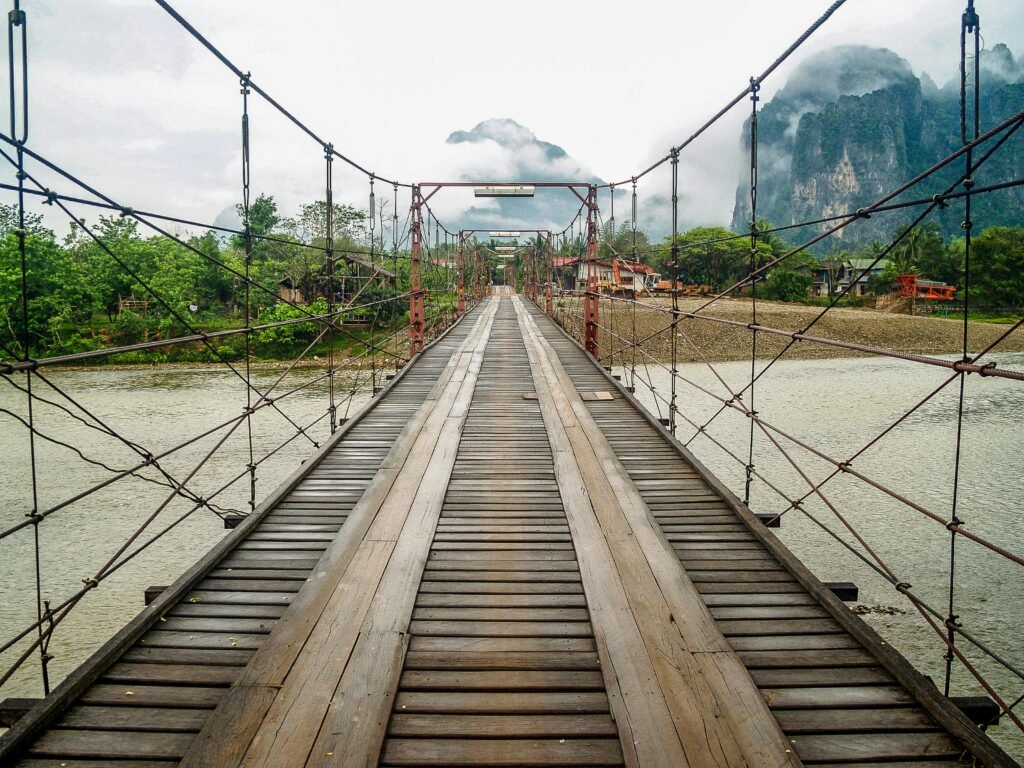
Image: Vang Vieng
Adventure Activities in Vang Vieng:
- Blue Lagoon: This vibrant turquoise swimming hole is perfect for cooling off. A large tree with rope swings adds to the fun, while the surrounding karst mountains create a stunning backdrop.
- Cave Exploration: The area features numerous caves to explore, including Tham Poukham (Blue Lagoon Cave) with its reclining Buddha, and Tham Chang, which offers spectacular views from its entrance.
- Nam Song River Activities: The Nam Song River flows through the karst landscape, offering opportunities for kayaking and tubing. The tubing experience has been made safer in recent years while still remaining fun.
- Hot Air Balloon Rides: For a truly unforgettable perspective, take a sunrise hot air balloon ride over the karst mountains and river. The views are absolutely spectacular and provide unique photo opportunities.

Backpacker Tips:
- Accommodation along the river offers the best views
- Renting a bicycle or motorbike is ideal for exploring the surrounding countryside
- The area can be visited year-round, though river activities may be limited during the dry season
- Many guesthouses organize group tours to popular attractions
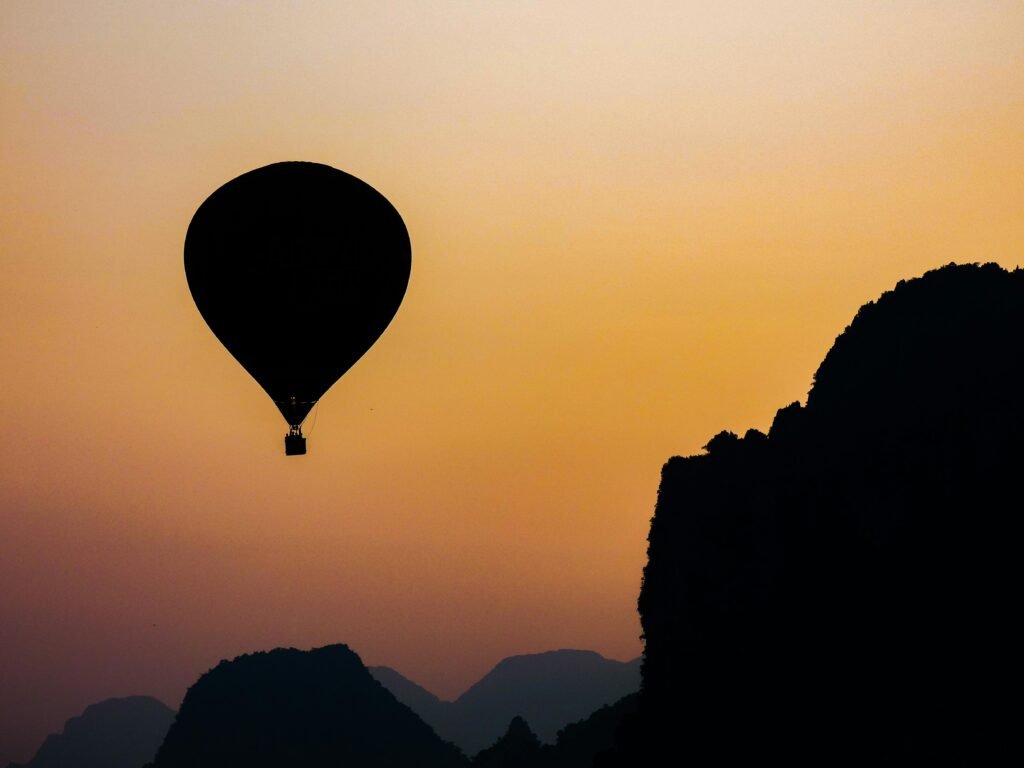
Image: Hot air balloon over Vang Vieng’s karst landscape
Bolaven Plateau: Coffee, Waterfalls, and Tribal Culture
The Bolaven Plateau in southern Laos offers a completely different experience from the rest of the country. This elevated region is known for its cooler climate, stunning waterfalls, coffee plantations, and diverse ethnic communities, making it one of the best places to visit in Laos for those seeking to venture beyond the typical tourist trail.
Highlights of the Bolaven Plateau:
- Tad Fane Waterfall: This impressive twin waterfall plunges over 100 meters into a deep gorge. The falls are most spectacular during the rainy season when water volume is at its highest.
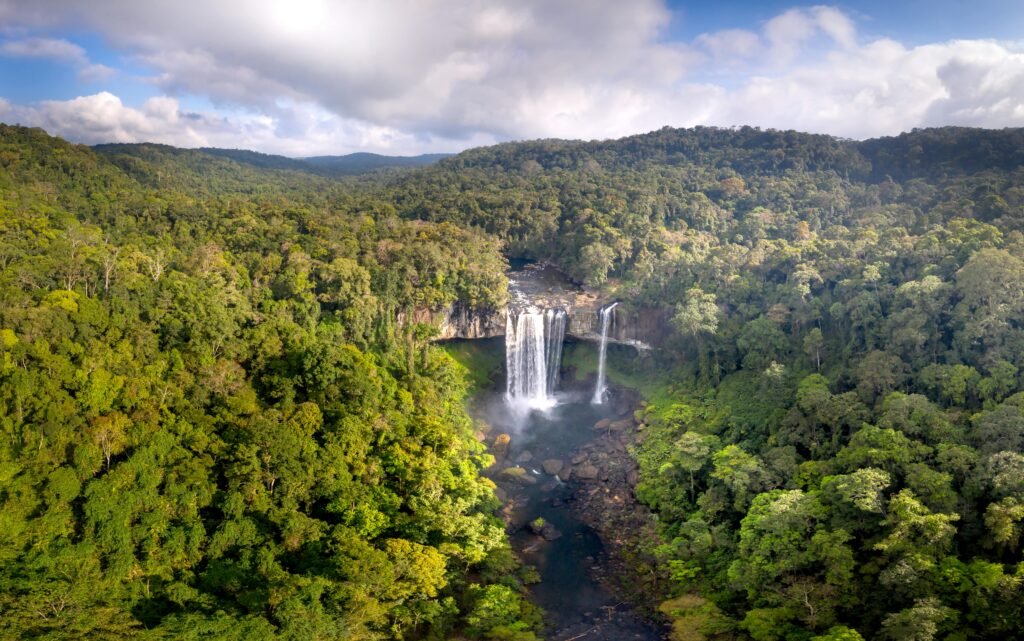
- Coffee Plantations: The plateau’s fertile soil and climate create ideal conditions for growing coffee. Several plantations offer tours where you can learn about the production process and sample some of Laos’ finest coffee.
- Hill Tribe Villages: The plateau is home to various ethnic groups including the Laven (who gave the plateau its name), Alak, and Katu peoples. Visiting these communities provides insight into traditional lifestyles that have remained largely unchanged for generations.
- Tad Lo Waterfalls: This series of three waterfalls (Tad Hang, Tad Lo, and Tad Suong) is surrounded by traditional villages and offers swimming opportunities and elephant experiences.
Practical Information:
- The plateau is most easily accessed from Pakse
- Renting a motorbike gives you the freedom to explore at your own pace
- A multi-day loop tour allows you to see the major attractions
- Bring warmer clothing as temperatures can drop significantly, especially at night
Si Phan Don (4000 Islands): Mekong River Serenity
In the southernmost part of Laos, the Mekong River spreads out to create an archipelago of islands known as Si Phan Don or “4000 Islands.” This tranquil area offers a perfect place to slow down and experience river life, making it one of the best places to visit in Laos for relaxation.
What to Experience in Si Phan Don:
- Don Det and Don Khon: These two connected islands are the most popular for tourists, offering a range of accommodations from basic bungalows to more comfortable guesthouses. The laid-back atmosphere is perfect for hammock-lounging and sunset watching.
- Irrawaddy Dolphins: Take a boat trip for a chance to spot the rare Irrawaddy dolphins that inhabit this stretch of the Mekong. Though sightings aren’t guaranteed, the boat ride itself is enjoyable.
- Khone Phapheng Falls: The largest waterfall by volume in Southeast Asia, these impressive rapids demonstrate the power of the Mekong. The falls effectively block navigation of the river, which is why a now-abandoned railway was built to transport goods around them.
- Cycling: The flat terrain of the islands makes them perfect for exploration by bicycle. Ride through villages, rice fields, and along the riverbanks at a leisurely pace.
Traveler Tips:
- The islands have limited electricity (often only available in the evenings)
- ATMs are scarce, so bring sufficient cash
- The area is best visited during the dry season when water levels are lower
- Allow at least three days to fully appreciate the slow pace of life
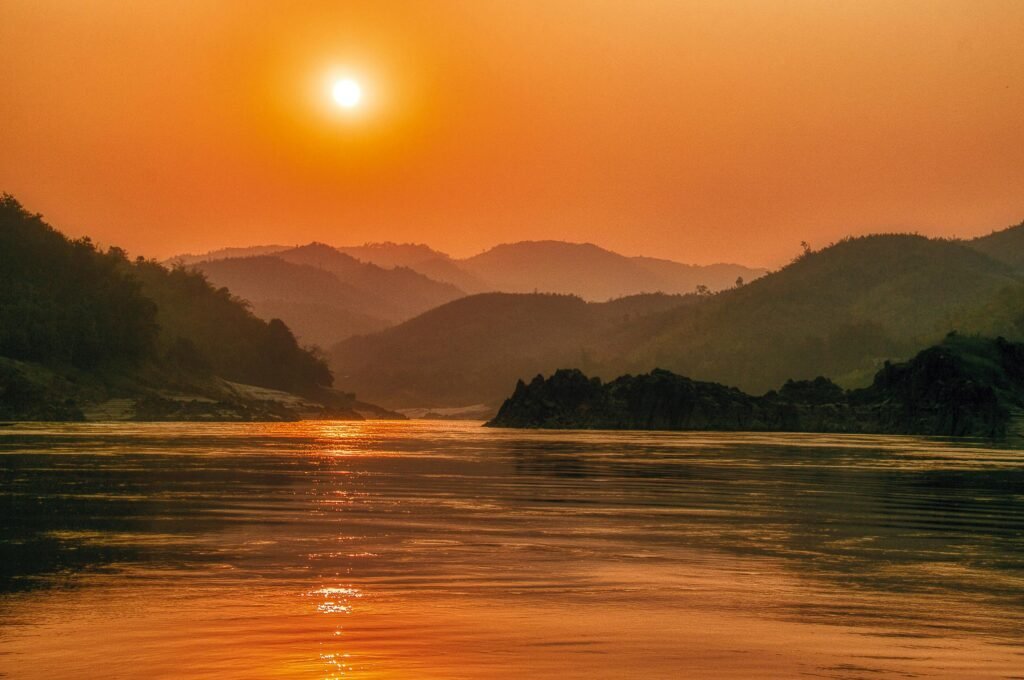
Image: Sunset over the Mekong at Si Phan Don
🌏 Exploring more of Indochina? Here’s your travel guide to Cambodia’s best destinations — temples, islands, and hidden culture gems await just across the border.
Planning Your Trip to the Best Places to Visit in Laos
Now that we’ve explored the top destinations, let’s focus on practical information to help you plan your Laos adventure.
Best Time to Visit Laos
The climate in Laos varies throughout the year, affecting your experience at different destinations:
November to February (Dry Season): This is generally considered the best time to visit most parts of Laos. The weather is cooler and dry, making it ideal for exploring cities, hiking, and outdoor activities. This is peak tourist season, especially in December and January.
March to May (Hot Season): Temperatures rise significantly, sometimes exceeding 35°C (95°F). This can make daytime exploration challenging, though water-based activities like visiting Kuang Si Waterfall become even more refreshing. The burning of fields during this time can create hazy conditions.
June to October (Rainy Season): The monsoon brings regular rainfall, which can affect road conditions and outdoor activities. However, this is when Laos is at its most lush and green, and waterfalls are at their most impressive. The rain typically comes in short, heavy bursts rather than all-day downpours.
Getting Around Laos
Transportation options in Laos have improved significantly in recent years:
Between Cities:
- Buses connect major destinations, ranging from local services to VIP buses with air conditioning
- Minivans often provide faster service but can be crowded
- Domestic flights connect Vientiane with Luang Prabang, Pakse, and other provincial capitals
- Slow boats on the Mekong offer a scenic way to travel between Luang Prabang and the Thai border
Within Cities and Towns:
- Tuk-tuks are the most common form of local transportation
- Bicycle rentals are widely available and ideal for exploring smaller towns
- Motorcycle rentals provide flexibility for exploring the countryside
- In Vientiane, ride-hailing apps are becoming increasingly available
Visa and Entry Requirements
Most nationalities require a visa to enter Laos. Options include:
- Visa on arrival: Available at major entry points including international airports and most land borders. Requires passport photos and a fee (typically $30-40 USD).
- E-Visa: Available online before travel for certain nationalities.
- Pre-arranged visa: Obtained from Lao embassies or consulates abroad.
Visas are typically issued for 30 days and can usually be extended in Vientiane or other provincial immigration offices.
Staying Connected in Laos
Reliable connectivity is essential for modern backpackers:
- Local SIM cards from providers like Unitel and LaoTel are inexpensive and offer good coverage in cities and towns
- For hassle-free connectivity, consider an eSIM solution from Gohub before your trip
- Wi-Fi is available in most accommodations and cafes in tourist areas, though speed and reliability vary
- Coverage can be limited in remote areas like parts of the Bolaven Plateau
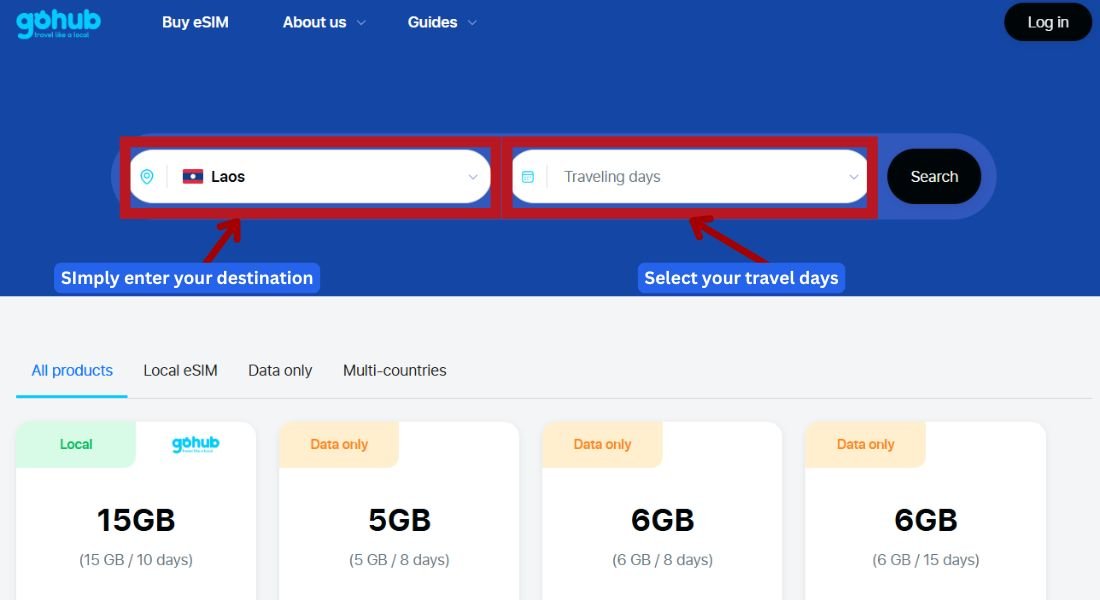
Image: Screenshot of the GoHub eSIM webpage, highlighting the destination input field with “Laos” selected, illustrating how users can easily search for eSIM data plans.
👉 Explore GoHub’s Laos eSIM plans now
Cultural Etiquette for Backpackers in Laos
Understanding and respecting local customs will enhance your experience in Laos:
Temple Etiquette
- Dress modestly when visiting temples (shoulders and knees covered)
- Remove shoes and hats before entering temple buildings
- Women should not touch or hand items directly to monks
- Ask permission before photographing people, especially monks
General Cultural Tips
- The traditional Lao greeting is the “nop” – pressing your hands together in a prayer-like gesture
- Avoid touching anyone on the head, as it’s considered sacred
- Public displays of affection are frowned upon
- Remove shoes when entering someone’s home
Sustainable Travel in Laos
As backpackers, we have a responsibility to minimize our impact:
- Support locally-owned businesses rather than international chains
- Participate in community-based tourism initiatives
- Avoid single-use plastics by carrying a reusable water bottle
- Respect wildlife by not participating in exploitative animal attractions
- Learn a few basic Lao phrases to connect with locals

Conclusion: Your Laos Adventure Awaits
From the UNESCO heritage of Luang Prabang to the adventure hub of Vang Vieng, from the serene 4000 Islands to the coffee plantations of the Bolaven Plateau, the best places to visit in Laos offer experiences that will stay with you long after your journey ends. As tourism in Southeast Asia continues to evolve, Laos remains a destination where authentic experiences and genuine connections are still possible.
Whether you’re seeking cultural immersion, natural beauty, adventure activities, or simply a place to slow down and reflect, Laos delivers on all fronts. The country’s combination of stunning landscapes, rich heritage, and warm hospitality creates the perfect backdrop for a meaningful backpacking adventure in 2025.
Before you embark on your journey to explore the best places to visit in Laos, ensure seamless connectivity throughout your trip with a Gohub eSIM. Stay connected while trekking through the Bolaven Plateau, sharing photos of Kuang Si Waterfall, or navigating the streets of Luang Prabang.
📶 From Luang Prabang to the Bolaven Plateau, stay online in Laos with Gohub’s Asia eSIM — instant setup, flexible data, and perfect for slow, soulful journeys.
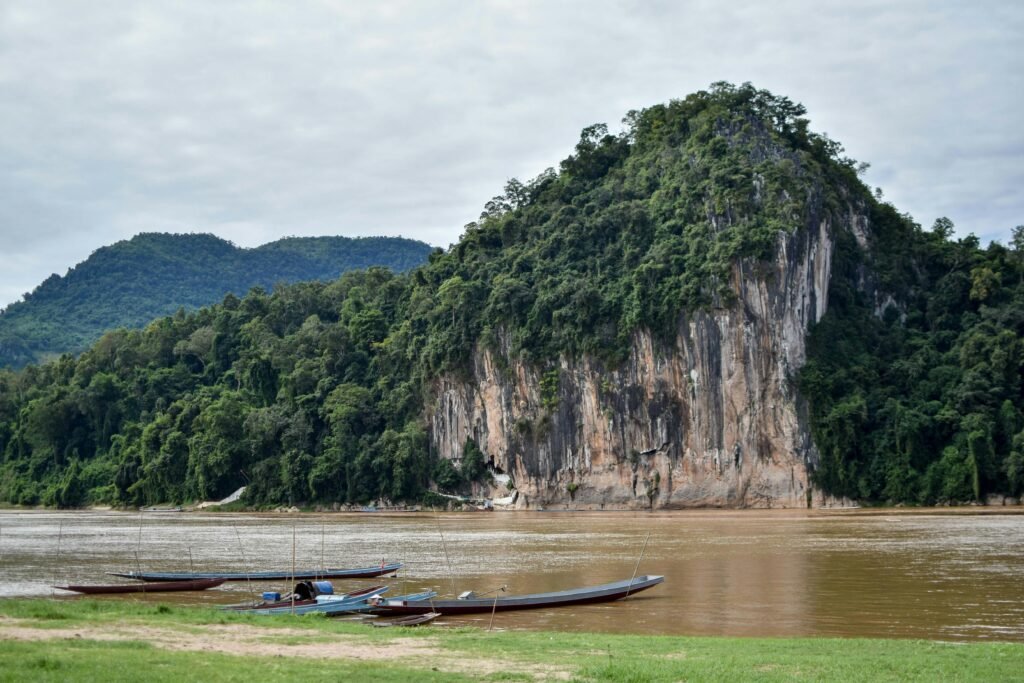
Image: Traditional Lao longboat

Image: Morning alms giving ceremony in Luang Prabang








